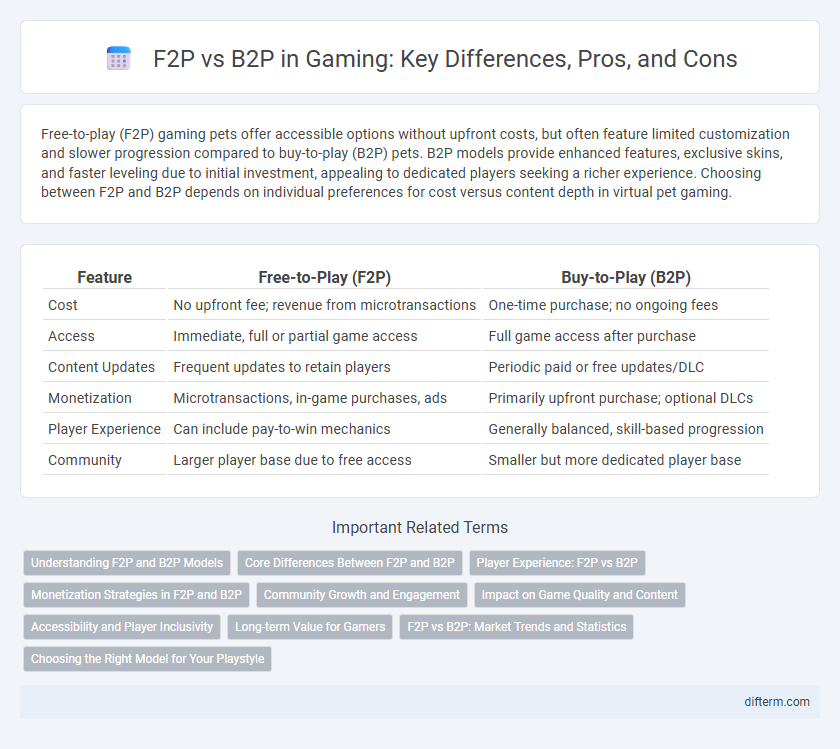Free-to-play (F2P) gaming pets offer accessible options without upfront costs, but often feature limited customization and slower progression compared to buy-to-play (B2P) pets. B2P models provide enhanced features, exclusive skins, and faster leveling due to initial investment, appealing to dedicated players seeking a richer experience. Choosing between F2P and B2P depends on individual preferences for cost versus content depth in virtual pet gaming.
Table of Comparison
| Feature | Free-to-Play (F2P) | Buy-to-Play (B2P) |
|---|---|---|
| Cost | No upfront fee; revenue from microtransactions | One-time purchase; no ongoing fees |
| Access | Immediate, full or partial game access | Full game access after purchase |
| Content Updates | Frequent updates to retain players | Periodic paid or free updates/DLC |
| Monetization | Microtransactions, in-game purchases, ads | Primarily upfront purchase; optional DLCs |
| Player Experience | Can include pay-to-win mechanics | Generally balanced, skill-based progression |
| Community | Larger player base due to free access | Smaller but more dedicated player base |
Understanding F2P and B2P Models
Free-to-play (F2P) and buy-to-play (B2P) are two dominant monetization models in the gaming industry, each offering distinct user experiences and revenue strategies. F2P games generate income through in-game purchases, advertisements, and microtransactions, appealing to a broad audience by allowing free access with optional paid content. B2P games require an upfront purchase, providing a complete gaming experience without ongoing payments, often prioritizing quality, narrative depth, and player commitment.
Core Differences Between F2P and B2P
Free-to-play (F2P) games offer unrestricted access without upfront costs, relying heavily on in-game purchases and microtransactions to generate revenue, whereas buy-to-play (B2P) games require an initial purchase for full access without mandatory ongoing payments. F2P models often feature continual content updates and monetization strategies like loot boxes or premium currency, which can influence gameplay balance and player progression. B2P games typically provide a complete experience upon purchase, focusing on upfront quality and avoiding pay-to-win mechanics, thus appealing to players seeking a more traditional gaming experience.
Player Experience: F2P vs B2P
Free-to-play (F2P) games offer access without upfront cost, relying on microtransactions that can impact player experience through potential pay-to-win mechanics or content gating. Buy-to-play (B2P) titles provide a one-time purchase for full access, often resulting in a more balanced and fair gameplay environment without aggressive monetization pressure. Players in B2P models typically enjoy a more immersive and uninterrupted experience, while F2P games cater to broader audiences but may introduce gameplay imbalances due to monetization strategies.
Monetization Strategies in F2P and B2P
Free-to-play (F2P) games primarily monetize through in-app purchases, microtransactions, and cosmetic items to capitalize on large player bases. Buy-to-play (B2P) titles rely on upfront purchases and occasional paid expansions or downloadable content (DLC) for revenue, emphasizing a one-time or episodic financial model. Both strategies target different user behaviors, with F2P focusing on long-term engagement and monetization through optional content while B2P prioritizes delivering a complete gaming experience upfront.
Community Growth and Engagement
Free-to-Play (F2P) models significantly boost community growth by lowering entry barriers, which attracts a larger, more diverse player base that fosters vibrant social interactions and frequent in-game events. Buy-to-Play (B2P) titles often create more dedicated and engaged communities due to the initial investment, encouraging deeper commitment and sustained player retention. Both models impact community engagement differently, with F2P driving mass participation while B2P emphasizes quality of interaction and long-term loyalty.
Impact on Game Quality and Content
Free-to-play (F2P) games often rely on microtransactions to generate revenue, which can lead to frequent content updates but sometimes at the expense of balanced gameplay and quality control. Buy-to-play (B2P) models typically offer a more polished and complete experience upfront, emphasizing game quality and narrative depth without intrusive monetization. The choice between F2P and B2P impacts developer priorities, influencing whether content is designed to maximize engagement or provide a refined, cohesive gaming experience.
Accessibility and Player Inclusivity
Free-to-play (F2P) games maximize accessibility by removing the upfront cost barrier, allowing a diverse range of players to join without financial commitment. Buy-to-play (B2P) models, while limiting initial access, often provide a more inclusive experience through balanced gameplay and fewer monetization pressures. Both models influence player inclusivity differently: F2P encourages broad participation, whereas B2P often fosters a more dedicated, engaged community.
Long-term Value for Gamers
Free-to-play (F2P) games often generate long-term value through continuous updates, cosmetic microtransactions, and large player communities, fostering sustained engagement without upfront costs. Buy-to-play (B2P) titles, by contrast, deliver value via a complete, high-quality experience with no ongoing payments, appealing to gamers seeking ownership and fewer in-game monetization distractions. Gamers prioritizing long-term enjoyment typically weigh F2P's evolving content and social interaction against B2P's stability and full access to core gameplay.
F2P vs B2P: Market Trends and Statistics
Free-to-play (F2P) games dominate the global gaming market, generating over 80% of mobile game revenue through in-app purchases and microtransactions, reflecting a strong consumer preference for no upfront costs. Buy-to-play (B2P) models maintain steady popularity in PC and console segments, with titles like "The Witcher 3" showcasing high initial sales and ongoing digital purchases without subscription fees. Market analysis reveals F2P's scalability and user base growth outpace B2P, though B2P sustains niche markets by offering full access to premium content upfront.
Choosing the Right Model for Your Playstyle
Free-to-play (F2P) models offer accessibility with no upfront cost, allowing gamers to enjoy content at their own pace while optional microtransactions can enhance customization and progression. Buy-to-play (B2P) games provide full access after a one-time purchase, delivering a typically more balanced and complete experience without pay-to-win concerns. Selecting between F2P and B2P depends on your preference for initial investment, game progression speed, and tolerance for in-game monetization.
F2P vs B2P Infographic

 difterm.com
difterm.com